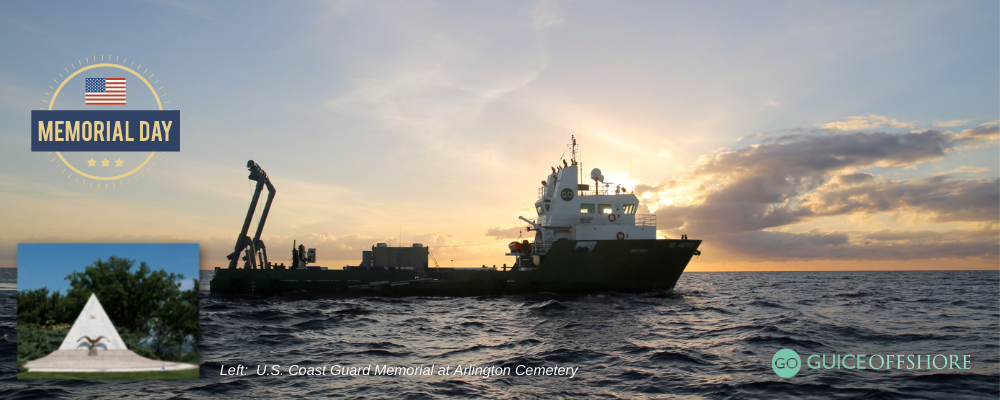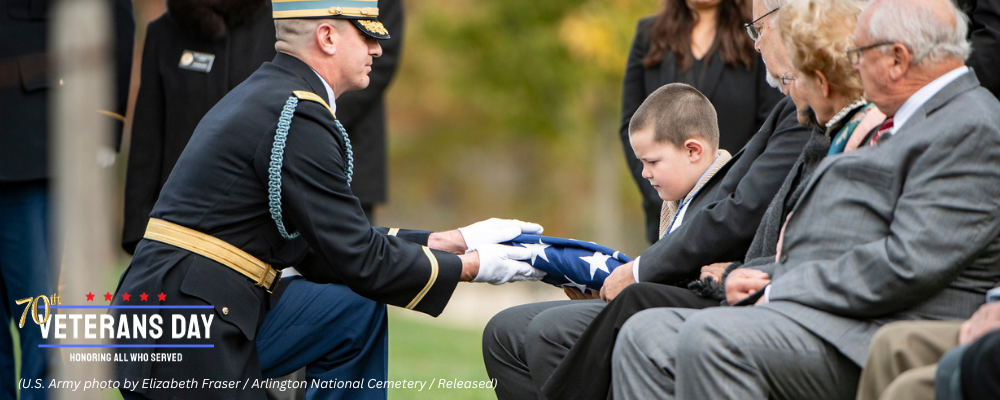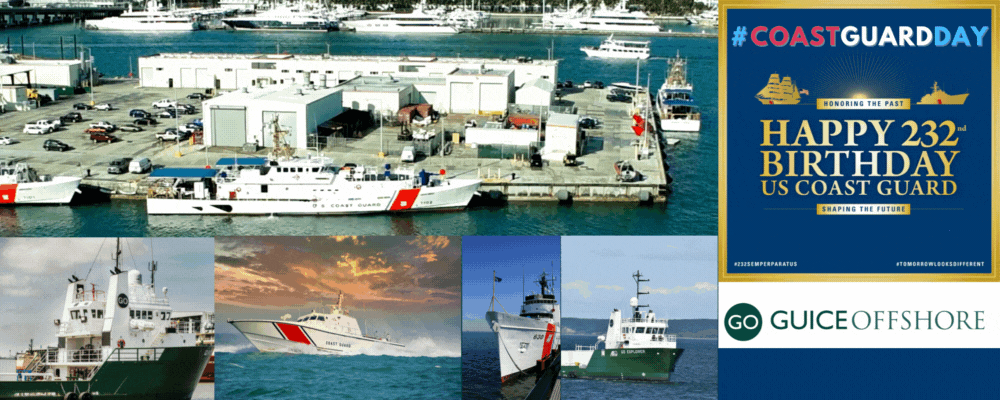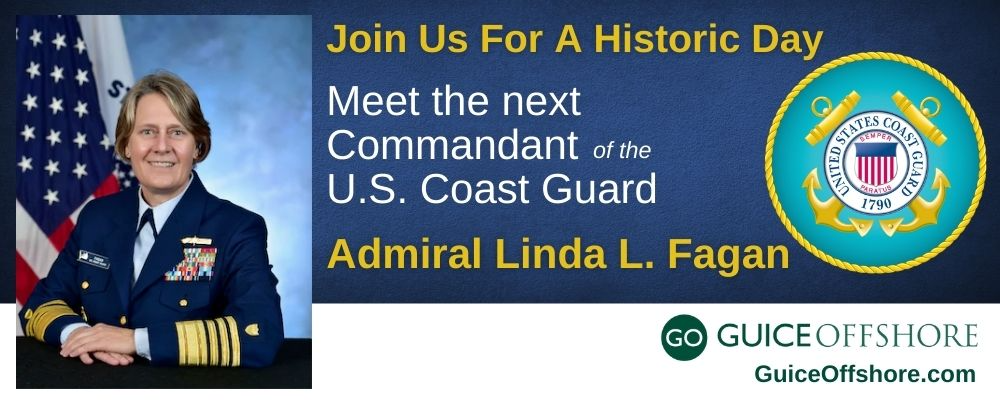At the USS Serpens Memorial dedication on November 16, 1950 at Arlington National Cemetery, Vice Admiral Merlin O’Neill, Commandant of the U.S. Coast Guard, gave a brief address, stating, “We cannot undo the past, but we can ensure that these men shall be respected and honored forever.”
This Memorial Day, Guice Offshore takes special note of the sacrifices made by members of our U.S. Coast Guard (USCG) throughout history.
On August 4, 1790, Congress authorized Secretary of the Treasury Alexander Hamilton’s proposal to build 10 cutters to protect the nation’s revenue by preventing smuggling and enforcing federal tariffs. Known as the system of cutters, Revenue Service and Revenue-Marine, this service would officially be named the Revenue Cutter Service in 1863. The cutters were placed under the control of the Treasury Department. On January 28, 1915, President Woodrow Wilson signed into law the “Act to Create the Coast Guard,” which combined the Revenue Cutter Service and a separate Life-Saving Service to form the United States Coast Guard.
The heroism and bravery of the Coast Guard are well represented at Arlington National Cemetery. Twelve former commandants are interred at the cemetery, and two notable landmarks, the Coast Guard War Memorial and the Serpens Memorial, honor the Coast Guard’s service.
Arlington National Cemetery has highlighted the history of its Coast Guard War Memorial with a series of guest blog posts from the USCG. These posts tell the story of the Coast Guard War Memorial and its significant role in honoring and remembering the heroism and ultimate sacrifices made by Coast Guardsmen during World War I.
Two of these are reprinted below. To view where each memorial stands at Arlington, click on the Section links below.
To read all the articles and learn about notable U.S. Coast Guard graves at Arlington, click here.
On May 30, 2022, watch the National Memorial Day Observance livestreamed from Arlington National Cemetery here.
Two tragic episodes in U.S. Coast Guard history, both of which occurred during World War I, prompted the construction of this memorial. On September 16, 1918, 19 members of the crew of the cutter Seneca volunteered for a rescue party to salvage the British steamer Wellington, which had been torpedoed by a German submarine. Eleven of those volunteers lost their lives when the Wellington exploded and sank. Only 10 days later, on September 26, 1918, an enemy submarine sank the cutter Tampa in the British Channel, killing all 131 on board.
The Coast Guard originated in 1915, when the Revenue Cutter Service merged with the U.S. Life-Saving Service. The Tampa and the Seneca had been ordered to operate as part of the Navy when the United States entered World War I in April 1918.
The U.S. Coast Guard Memorial was dedicated on May 23, 1928. Architect George Howe and sculptor Gaston Lachaise captured the spirit of the Coast Guard’s legendary steadfastness in the monument’s rock foundation and pyramid design. Above the Coast Guard motto Semper Paratus (“Always Ready”), a bronze seagull appears poised to lift off into flight. The seagull symbolizes the Coast Guard’s tireless vigil over the nation’s maritime territory. The names of the vessels Seneca and Tampa and their crewmen, as well as all Coast Guard personnel who lost their lives during World War I, are inscribed on the sides of the monument.
The U.S. Coast Guard Memorial sits on a triangular plot of land between Jessup and Dewey Drives, near the southern edge of the cemetery.
Section 34
The destruction of the USS Serpens (AK-97) during World War II is the largest single disaster in the history of the United States Coast Guard.
Named after the Serpens constellation, the USS Serpens was a cargo ship commissioned in May 1943. On the night of January 29, 1945, the 14,250-ton freighter was anchored off Lunga Beach, Guadalcanal in the British Solomon Islands, carrying ammunition and other cargo bound for U.S. bases in the Pacific. While the crew was loading depth charges into the holds, a massive explosion suddenly occurred. The explosion destroyed the entire ship, save for its bow, which sank to the bottom of the ocean. Two hundred and fifty men lost their lives: 193 Coast Guard sailors, 56 U.S. Army soldiers and Dr. Harry M. Levin, a U.S. Public Health Service surgeon. Only two bodies could be identified.
Ten members of the Serpens’ crew survived. The ship’s commanding officer, Lieutenant Commander Perry Stinson, another officer and six crewmen had been ashore on administrative business. Two U.S. Coast Guard crewmen who were on board survived the explosion: Seaman 1st Class Kelsie Kemp and Seaman 1st Class George Kennedy, who were both awarded the Purple Heart.
Initially, the Coast Guard believed that a Japanese attack had caused the blast. A court of inquiry, however, found no evidence of enemy action. In 1949, the U.S. Navy closed the case, determining that the disaster had been caused by “an accident intrinsic to the loading process.” Speculation about what caused the Serpens’ destruction continues to this day.
Remains of the 250 casualties were originally buried at the Army, Navy and Marine Cemetery in Guadalcanal, with a full military honors service. On June 15, 1949, the remains were reinterred in Section 34 at Arlington National Cemetery, in 52 caskets and 28 graves. Some 1,500 people attended the reinterment service, at which Catholic, Protestant and Jewish chaplains officiated. The U.S. Marine Corps Band sounded Taps, and a Gold Star Mother escorted by an American Legionnaire placed a white carnation on each casket.
The USS Serpens Memorial was dedicated on November 16, 1950. Attended by approximately 100 relatives of the victims and several hundred others, the dedication ceremony included the U.S. Army Band (“Pershing’s Own”) and color guards from the Coast Guard and The Old Guard.
Arlington National Memorial Day Observance 2022 Livestream Link
The nation’s 154th National Memorial Day Wreath-Laying and Observance Program to honor America’s fallen will be live-streamed from Arlington National Cemetery (ANC) at noon EDT, Monday, May 30.
The U.S. Army Military District of Washington will conduct a Presidential Armed Forces Full Honor Wreath-Laying Ceremony at the Tomb of the Unknown Soldier, followed by an observance program hosted by the Department of Defense in the Memorial Amphitheater at Arlington National Cemetery. A prelude by the U.S. Army Band “Pershing’s Own” will begin in the amphitheater at 11:15 a.m. (ET)
The public is encouraged to view the ceremonies live at: www.dvidshub.net/webcast/28869.
If you are planning to visit the cemetery over Memorial Day weekend, please review access instructions, tips and listing of scheduled events at https://arlingtoncemetery.mil/Visit/Getting-Here/Directions.
NOTE: Attendees will be required to pass through a security checkpoint to gain access to the cemetery and ceremony. Prohibited items include: large bags or backpacks, firearms and weapons of any type, laser pointers, aerosol containers, soda cans, umbrellas, coolers, picnic baskets, tripods, lighters, screwdrivers (or similar tools), air horns, personal protection sprays, and insulated beverage containers. Clear plastic water bottles are permitted.
For more information about Arlington National Cemetery, visit the cemetery’s website at www.arlingtoncemetery.mil
For more information about the wreath-laying or observance program, email the U.S. Army Military District of Washington Public Affairs Office at usarmy.mcnair.mdw.mbx.mediadesk-omb@mail.mil.



